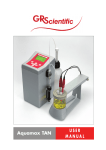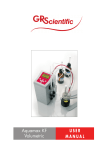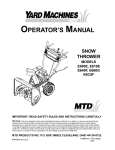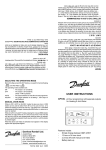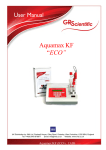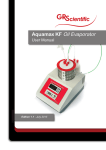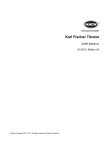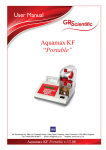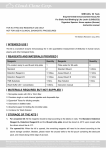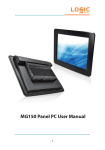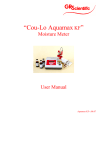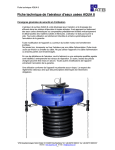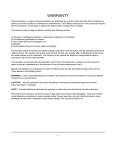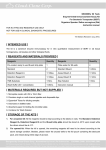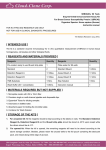Download USER MANUAL Aquamax MicroTAN
Transcript
Aquamax MicroTAN USER MANUAL UK Distribution by IMA Ltd: Phone: +44 (0)1943 878877 Email: [email protected] Web: www.ima.co.uk GUARANTEE The Aquamax MicroTAN titrators are guaranteed against any manufacturing defect or component failure. GRScientific will repair or replace, free of charge, any defective component or parts of the instruments under guarantee. This guarantee does not cover damage caused by accident, improper use or internal handling by unauthorised persons. Syringe and valve will be replaced under guarantee once our after sales service confirms they have a factory defect. This guarantee does not cover defects caused by: - incorrect use, - damage caused by accidents, - premature wear caused by certain working conditions. Electrodes are also guaranteed against manufacturing defects. GRScientific will replace any sensor deemed to have factory defects free of charge, once confirmed by our After Sales Service. This guarantee does not cover defects caused by: - incorrect use, - normal sensor wear, - logical premature wear caused by certain samples, - damage caused by accidents. Validity Instrument: 5 years. Sensors: 6 months In the event of failure Contact your local GRScientific dealer. The continuous improvement of our instruments can bring about differences between the information written in this manual and the purchased instrument. The data, figures and descriptions contained in this manual cannot be legally asserted. GRScientific reserves the right to make changes and corrections without prior notice. 2 Aquamax MicroTAN - Ed. April. 2012 INDEX Guarantee . . . . . . . . . . . . . . . . . . . . . . . . . . . . 2 Declaration of Conformity . . . . . . . . . . . . . . . . 4 Safety measures . . . . . . . . . . . . . . . . . . . . . . . 5 Presentation . . . . . . . . . . . . . . . . . . . . . . . . . . 5 Required reagents . . . . . . . . . . . . . . . . . . . . . . 5 Installation . . . . . . . . . . . . . . . . . . . . . . . . . . . 6 Installation of the syringe tubes Installation of the syringe Electrode Reaction vessel General view . . . . . . . . . . . . . . . . . . . . . . . . . 8 Description . . . . . . . . . . . . . . . . . . . . . . . . . . . 9 Keypad External key board Rear panel Stand-by screen Start up . . . . . . . . . . . . . . . . . . . . . . . . . . . . . 10 Quick guide . . . . . . . . . . . . . . . . . . . . . . . . . . 11 Reagents loading, Manual activation . . . . . . . . 12 Syringe Stirrer Working procedure . . . . . . . . . . . . . . . . . . . . . 13 Calibration Blank Titration Display data (Data-logger) . . . . . . . . . . . . . . . 17 Print . . . . . . . . . . . . . . . . . . . . . . . . . . . . . . . . 17 System . . . . . . . . . . . . . . . . . . . . . . . . . . . . . . 18 Warning and error messages . . . . . . . . . . . . . 18 RS 232 C interface . . . . . . . . . . . . . . . . . . . . . 19 Units . . . . . . . . . . . . . . . . . . . . . . . . . . . . . . . . 19 Statistical calculations . . . . . . . . . . . . . . . . . . . 20 Specifications . . . . . . . . . . . . . . . . . . . . . . . . . 20 Analysis of samples with sub-ASTM D664 TAN . 21 3 Aquamax MicroTAN - Ed. April. 2012 declaration of CONFORMIty CE Declaration of conformity We GRScientific P.O. BOX 242, Ampthill, Bedfordshire MK45 5AQ. UK declare under our sole responsibility that the product, Description Aquamax MicroTAN to which this declaration relates is in conformity with the following normative documents: Low-voltage directive 2006/95/CE Standard UNE-EN 61010-1 UNE-EN 61010-1 07-2002 11-2003 EMC Directive 2004/108/CE 10-2006 Standard UNE-EN 61326-1 Place and date Ampthill, 19.10.2009 Edition: October 2009 GRScientific 4 Aquamax MicroTAN - Ed. April. 2012 SAFETY MEASURES Warning Please, read carefully this information before installing and using the instrument. 3. Read carefully the manual of the instrument. 4. In case of liquids splashes, wipe off immediately. The instrument is not waterproof. 5. Exclude the following environmental influences: - vibrations - direct sunlight - atmospheric humidity higher than 80 % - corrosive gases present - temperature below 15 ºC and above 40 ºC - powerful electric and magnetic fields. 6. Only use original accessories and spare parts. 7. Have the instrument serviced only by GRScientific Service. These safety measures do not purport to address all safety problems associated with the use of this instrument. It is the responsibility of whoever uses this instrument to consult and establish appropriate health and safety practices and determine the applicability of regulatory limitations prior to use. 1. Never work in an environment subject to explosion hazards. The housing of the instrument is not gas tight. 2. Using chemicals, comply with the general instructions for hazard prevention and safety rules, e.g. wear protective clothing, eye protection and gloves. PRESENTATion 1 x Calibration flask of 50 ml for buffer pH 11, stirring bar included, code 91 93 24. 1 x MicroTAN vessel, 25 ml, code 92-9323-25. 1 x Pack of white O-rings (10 units) for valve screws, code 91 87 34. The Aquamax MicroTAN is specific titrator for Total Acid Number determination in accordance with ASTM D 664. The messages on the instrument’s display guide the user making it suitable for routine analysis. TAN value in the sample. The Aquamax MicroTAN express the result in mg KOH / g sample. Optional accessories Supplied accessories Thermal printer, code 91 82 01. Dotmatrix printer, code 91 82 00 Standard PC keyboard, code 91 90 13. Communication software TiCom, code 91 86 82. Aquamax MicroTAN 1 x Plug in power supply 90-264 VAC, 47-63 Hz, 24 Volt DC, code 91 87 36. 1 x TLL SL syringe, 10 ml, code 91 92 29. 1 x Burette inlet tube with bottle cap DIN 45 screw, code 91 87 05. 1 x Burette outlet tube with antidiffuser device, code 91 87 38 . 1 x Cotton filter cartridges, code 91 91 99. 1 x Support for electrode and tube with magnetic stirrer, code 91 93 22. 1 x Micro combination pH electrode, code 92-P21NS14. 1 x Electrolyte for reference electrode LiCl 1 M in ethanol, bottle of 250 ml, code 91 95 20. required reagents Titrant reagent: KOH 0.1 mol/l in 2-propanol. Warning: KOH causes severe burns, 2-propanol is flammable. Titration Solvent: Mixture of water / 2-propanol / toluene (in relation 5 / 495 / 500). Warning: Flammable Aqueous pH 11 Buffer solution LiCl 1 M in ethanol, electrolyte for refilling the reference electrode 5 Aquamax MicroTAN - Ed. April. 2012 INSTALlAtIoN 1. Remove the protecting stickers from the inlet and outlet of the valve. 2. Check that there is a small white O-ring in every screw. It must be in horizontal position. This O-ring ensures the union tightness. Remove the protecting sticker. White O-ring inside. Attention: If the O-ring is not inside, check that it is not stuck on the protecting sticker. ... of the burette tubes Reagent outlet tube Reagent inlet tube From syringe to titrant vessel 1. Screw the reagent outlet tube on the position placed on the left side of the valve. Place the tube on the sensor support. 2. Screw the reagent inlet tube on the position placed on the right side of the valve. Introduce the tube into the reagent bottle and screw the cap. From titrant bottle to syringe I mportant: In order to avoid possible reagent leakage, it is strongly advisable to periodically check and re-tighten the screw joints, especially during the first days of use of the Aquamax TAN. ... of the syringe 1 2 Electrovalve 2 13 Syringe glass barrel 4 2 Fixing cylinder Syringe plunger 1 Cursor 35 3 1. Introduce 1/3 part of the plunger in the glass barrel. 4. Place the fixing cylinder on the metal clamp. 2. Put the fixing cylinder as shown. Switch on the instrument. The cur- 5. Pull the plunger if required and screw it on the cursor. sor automatically goes to down position. I mportant: In order to avoid possible reagent leakage, it is strongly advisable to periodically check and re-tighten the syringe in the valve, especially during the first days of use of the Aquamax MicroTAN. 3. Screw the syringe on the valve. 6 Aquamax MicroTAN - Ed. April. 2012 instalLaTion ... preparation of the electrode for use Important: Electrodes are made from glass. Handle them carefully at all time. Micro pH combination electrode 1. Connect the cable to the rear panel of the instrument, see Rear Panel, page 9. 2. Remove the storage protector sleeve. 3. Check level of electrolyte. Top up with LiCl 1M in ethanol if required. 4. Remove filling cap during use. Recommendations related to the use of the electrode: During storage, close the filling port with the cap. Maintain electrolyte level. Refill periodically with LiCl 1M in ethanol. Ensure that there are no air bubbles in electrolyte. Ensure glass bulb is then immersed in water to maintain hydration. If sample residue remains after cleaning another solvent such as xylene, heptane or chloroform may be used to remove residue. Afterwards, soak briefly in 2-propanol to remove the solvent, then soak in water for 3 to 5 minutes to rehydrate. 7 Aquamax MicroTAN - Ed. April. 2012 GENERAL VIEW Connect the plug-in power supply, electrode cable and magnetic stirrer to the rear panel. KOH 0.1 M in 2-propanol 8 Aquamax MicroTAN - Ed. April. 2012 DESCRIPTION Keypad Rear panel On/Off. ESC OK Move backwards in the menus. Interrupt a Manual activation. Interrupt a titration. Move forwards in the menus confirming the option marked in gray (in bold in this manual). In the data-logger menu it displays the first register. RS 232 C BALANCE SAMPLER RS 232 C PRINTER PC 1 2 3 GLASS ELECTRODE Selection between the different displayed options. Selection of numeric values. s In the Data-logger it displays the next register. In Manual activation it empties the syringe through the outlet tube. Selection between the different displayed options. Selection of numeric values. In the Data-logger it displays the previous register. In Manual activation it loads the syringe through the inlet tube. 24 VDC 6 REFERENCE ELECTRODE STIRRER INSTRUMENT OFF 5 4 5 Connections for: 1, External PC keyboard. Aquamax TAN 2, Balance. Idioma ESPAÑOL 3, Printer or PC. Language ENGLISH 4, Micro pH Electrode. Lingua ITALIANO 5, Not used Langue FRANÇAIS 6, Magnetic stirrer. 7, Plug in power supply. s Move forwards a digit when entering a numeric value. Show the next display in those menus that have more than one. s s PS/2 KEYBOARD MOUSE Move backwards a digit when entering a numeric value. Show the previous display in those menus that have more than one. In Manual activation it empties the syringe through the inlet tube. OK DATA OUTPUT Stand-by screen Deactivated If the instrument is not used for more than 5 minutes it will automatiFor Printer cally display the “Stand-by” screen. Press any key to go back the previous screen. FortoPC External keyboard: Standard PC keyboard Its main use is the text introduction: header, user name, reagent name, and alphanumeric sample identification. It allows the introduction of numeric data too. If the automatic sample identification is used, it is not necessary the connection of a PC keyboard to the Aquamax MicroTAN. OK Serial Nº Calendar Aquamax TAN Software version SN: 92000 V 2.0 29-10-2009 13:12:01 Hour MAIN M E N U ▲ ANALYZE CALIBRATION MANUAL ACTIVATION DISPLAY DATA SYSTEM ▲ INSTRUMENT OFF 9 Aquamax MicroTAN - Ed. April. 2012 MAIN M E N U ▲ ANALYZE START UP CALIBRATION MANUAL ACTIVATION DISPLAY DATA SYSTEM ▲ Switch on... When switching on the instrument for the first time must be selected: Language. Select the corresponding language. Data output. Select “Deactivated” if neither printer nor PC are connected. Selecting “Printer” or “Computer”, the Aquamax MicroTAN will ask for: - Report header . Two lines of 20 characters for company name introduction, etc. The use of a PC keyboard is necessary. - S ample ID. “Manual”, sample identification introduction per each sample; “Automatic”, consecutive sample identification assigned by the titrator. The instrument presents the Main Menu. ...for the first time ...successive times INSTRUMENT OFF INSTRUMENT OFF Aquamax TAN Idioma Language Lingua Langue From the option SYSTEM in the main menu, the user can select: weight entrance, date and hour, etc. (see page 18). ESPAÑOL ENGLISH ITALIANO FRANÇAIS OK Aquamax TAN SN: 92000 V 2.0 29-10-2009 13:15:01 DATA OUTPUT OK ▲ ANALYZE ▲ Deactivated For Printer For PC MAIN M E N U CALIBRATION MANUAL ACTIVATION DISPLAY DATA SYSTEM Aquamax TAN SN: 92000 V 2.0 29-10-2009 13:12:01 MAIN M E N U ▲ ANALYZE CALIBRATION MANUAL ACTIVATION DISPLAY DATA SYSTEM ▲ INSTRUMENT OFF Aquamax TAN SN: 92000 V 2.0 29-10-2009 13:15:01 MAIN M E N U ▲ ANALYZE 10 CALIBRATION MANUAL ACTIVATION DISPLAY DATA Aquamax SYSTEM MicroTAN - Ed. April. 2012 ▲ QUICK guiDE MAIN MENU OK ▲ ANALYZE CALIBRATION MANUAL ACTIVATION DISPLAY DATA ESC SYSTEM ▲ TAN < 0.1 TAN > 0.1 TAN > 1 BLANK MAIN MENU CALIBRATION OK ▲ ANALYZE Attention CALIBRATION Immerse the electrodes MANUAL ACTIVATION in buffer pH 11 DISPLAY DATA Start ESC SYSTEM ▲ ANALYZE TAN > 0.1 Set titration Statistics: No Sample ID: 000001 ESC Continue... See TAN DETERMINATION (page 15) CALIBRATION OK -272 mV 00:05 ESC See CALIBRATION (page 13) ▲ ▲ OK ▲ ▲ ANALYZE MAIN MENU OK ▲ ANALYZE CALIBRATION MANUAL ACTIVATION DISPLAY DATA ESC SYSTEM MANUAL ACTIVATION Burette Stirrer See MANUAL ACTIVATION (page 12) ▲ ▲ MAIN MENU OK ▲ ANALYZE CALIBRATION MANUAL ACTIVATION DISPLAY DATA ESC SYSTEM D ATA L O G G E R Empty Data Logger Display data Print data (*) Memorized value ▲ ▲ ▲ ▲ SYSTEM MAIN MENU OK ▲ Operator's name (**) ▲ ANALYZE CALIBRATION Data output MANUAL ACTIVATION Report header (**) DISPLAY DATA Sample ID (**) ESC SYSTEM ▲ ▲ * See DISPLAY DATA (page 17) SYSTEM ▲ Weight entrance Date and Hour Display contrast Language See SYSTEM (page 18) ▲ ▲ This option will appear only if a printer is connected. ** These options will only appear if Data Output is activated. 11 Aquamax MicroTAN - Ed. April. 2012 manual ACTIVATION Syringe. Reagent loading 1. Introduce the inlet tube in the bottle containing KOH 0.1 mol/l in 2-propanol. MAIN MENU ▲ ANALYZE CALIBRATION MANUAL ACTIVATION DISPLAY DATA 2. Put a vessel for waste on the titration stand below the outlet burette tube. 3. From Main Menu, select the option Manual Activation, Burette. Press successive times the keys corresponding to Fill and Empty until the liquid circuit is completely filled. It is recommended to repeat this process several times with small volumes. SYSTEM ▲ OK OK Burettes Stirrer Burette Return ▲ Empty Fill ▲ MANUAL ACTUATION The syringe movement is interrupted by pressing the key ESC or when the syringe piston reaches the position up or down. - Fill, the syringe fills with reagent from the bottle. - Empty, empty the syringe content into the titration vessel - Return reagent, this options allows to return the syringe content into the bottle. It is recommended at the end of the working session or before cleaning. ▲ ▲ Stirrer MANUAL ACTUATION Important: Burette -A t the beginning of the working day, fill approx. 50% of the syringe volume and empty in waste beaker. In this way, possible air bubbles formed in the liquid circuit will be eliminated. Stirrer OK Stirrer OFF 30 % ON - It is recommended to return syringe content into the reagent bottle at the end of the working session or before cleaning. - T o clean the liquid circuit, the procedure of Reagent Loading should be carried out with ethanol. Stirrer This option allows to activate the stirrer. Once activated the stirring speed can be modified with the arrow keys up and down. working procedure Installation TAN determination 1. Install the instrument, titration stand and electrodes in accordance with the chapters Installation, General View and Rear Panel (pages 6-9). It consists in 3 steps: 2. L oad the titrant reagent, KOH 0.1 mol/l in 2-propanol, into the syringe, see Manual ActIVation page 12. 1. Calibrate the electrode with buffer pH 11. See WORKING PROCEDURE: CALIBRATION, page 13. 2. Blank determination. See WORKING PROCEDURE: BLANK DETERMINATION, page 14. 3. TAN determination From the Main Menu select the option ANALYZE. See WORKING PROCEDURE: TAN DETERMINATION page 15. 12 Aquamax MicroTAN - Ed. April. 2012 WORKING procedURE: CALIBRATION The calibration with buffer pH 11 should be performed daily. MAIN MENU ANALYZE CALIBRATION MANUAL ACTIVATION DISPLAY DATA SYSTEM 1. P our approx. 25 ml of buffer 11 in the supplied calibration flask. 2. P lace it on the titration stand and immerse electrode. The liquid should cover the sensitive part of both electrode. 3. F rom the Main Menu select Calibration and follow the instructions on the instrument’s display. OK Rinse the electrodes pair with analytical grade water. Dry with soft tissue. Immerse in the calibration flask with buffer pH 11. CALIBRATION Attention Immerse the electrodes in buffer pH 11 Start Recommendations: - Calibrate the electrode daily. The buffer solution should be in good conditions and at room temperature. - After use close the calibration flask. This portion of buffer pH 11 can be used for performing about 3-4 calibrations. After that replace it by fresh one. OK CALIBRATION - The bottle with buffer pH 11 should be stored in cool, dry place avoiding direct sun light. After use, close the bottle with the corresponding cap. -272 mV 00:05 30 % - The stirring speed can be modified during Calibration. Nevertheless, using the supplied calibration flask and magnetic bar, the factory setting ensures stable stirring speed. Automatically after 1 minute measurement. OK CALIBRATION Memorized value Continue... OK MAIN MENU ANALYZE CALIBRATION MANUAL ACTIVATION DISPLAY DATA SYSTEM 13 Aquamax MicroTAN - Ed. April. 2012 WORKING procedURE: BLANK DETERMINATION This process must be carried out when the instrument is used for the first time and for every new batch of titration solvent . Additionally, it is recommended to re-check periodically the blank value of the titration solvent. MAIN MENU ANALYZE CALIBRATION MANUAL ACTIVATION DISPLAY DATA SYSTEM 1. In the titration vessel introduce 25 ml of titration solvent and the stirring bar. OK 2. R inse the electrode with 2-propanol. ANALYZE TAN < 0.1 TAN > 0.1 TAN > 1 BLANK 3. P ut the vessel containing the solvent solution on the titration stand. From the Main Menu select the option ANALYZE. Perform titration using the program “Blank”. 4. O nce the titration has finished, select “Accept result”. In this way the Blank value is stored automatically in all TAN titration programs. Select BLANK with the down arrow key. OK ANALYZE BLANK Set titration Delete blank Statistics: No Sample ID: 000001 Continue... 5. O nce the titration has finished, rapidly remove the vessel with the titrated blank from the titration stand. Do not allow electrodes to remain immersed in titration solvent for any appreciable period of time between titration. OK 6. Store the electrode as described in Electrode storage between samples, page 15. BLANK Sampe ID: 000001 Insert sample More features: Start titration - Interrupted process A titration can be interrupted at any moment by pressing the key ESC. On the display appears: Process interrupted Quit Continue Select the desired option with the arrow keys and accept with OK. OK BLANK 0.130 ml - 255 mV ID: 000001 - Access to other parameters Set titration. If this option is selected, two titration parameters can be modified: - Advanced stirring: 20 s - Initial addition: 0.000 ml The above mentioned values correspond to the factory setting of the instrument. Delete blank. This option allows erasing the last blank value stored in memory of the Aquamax MicroTAN. Statistics. No: no statistics calculation in the blank determination. Yes: statistics calculation in the blank determination. The number of samples to be performed should be programmed. See STATISTICS CALCULATION, page 20. Sample ID With Deactivated Data Output, it is always numeric and sequential assigned by Aquamax MicroTAN. With Activated Data Output, the sample ID can be Automatic (numeric and sequential assigned by Aquamax MicroTAN) or Manual (allowing introduction of alphanumeric code per sample with the help of external PC keyboard), see SYSTEM page 18. 04:38 BLANK If required, at this stage the stirring speed can be modified with the arrow keys. Nevertheless the factory setting of 30% stirring speed ensures optimal homogenization. b = 0.146 ml Accept result Repeat result OK ANALYZE TAN < 0.1 TAN > 0.1 TAN > 1 BLANK 14 Aquamax MicroTAN - Ed. April. 2012 WORKING procedURE: TAN DETERMINATION 1. Prepare the sample if required as described in the norm ASTM D 664, section 10. MAIN MENU ANALYZE CALIBRATION MANUAL ACTIVATION DISPLAY DATA SYSTEM 2. Into the titration vessel, introduce a weighed quantity of sample. 3. A dd 25 ml of titration solvent and one stirring bar. OK 4. P lace the titration vessel on the titration stand. From the Main Menu select the option ANALYZE. Perform the titration using the corresponding program in accordance with the expected TAN value. ANALYZE TAN < 0.1 TAN > 0.1 TAN > 1 BLANK 5. A fter the analysis, the instrument presents the result in mgKOH/g. Note 1: Select with Note 2: Select with , modify with and accept with OK 6. O nce the titration has finished, rapidly remove the vessel with the titrated sample from the titration stand. Do not allow electrodes to remain immersed in titration solvent for any appreciable period of time between titration. and accept with ANALYZE TAN > 0.1 Set titration Statistics: No Sample ID: 000001 7. Store the electrode as described in Electrode storage between samples, page 15. Continue... OK 8. Next sample. If required selecting other titration program, press the key ESC until appearing the corresponding display. TAN > 0.1 Note 1: Introduce Select with Sample 1/1 Sampe ID: 000001 Note 2: Select with Electrodes storage: , modify with and accept with Weight: 00.0000 g Between samples: At the end of the titration, rinse the electrode with 2-propanol. Immerse the glass electrode in water for 3 minutes to rehydrate the aqueous gel layer of the membrane. Prior to beginning the next sample, soak the electrode with titration solvent. The same solvent cleaning beaker, 2-propanol beaker and water may be used for short series of samples. They should be changed at reasonable intervals before contamination builds up. with the massandofaccept the sample OK TAN > 0.1 Sampe ID: 000001 Insert sample Start titration OK TAN > 0.1 For middle and long period of time: - When the electrode is not in use, it should be stored in the storage protector containing pH 4,5-5,5 reagent grade water. 0.146 ml - 55 mV ID: 000001 Important: At the end of the day return the reagent from the syringe to the original bottle, see MANUAL ACTIVATION. 01:38 If required, at this stage the stirring speed can be modified with the arrow keys. Nevertheless the factory setting of 30% stirring speed ensures optimal homogenization. BLANK TAN 0.15 mg KOH/g Next sample OK TAN > 0.1 Sample 1/1 Sampe ID: 000002 Weight: 00.0000 g 15 If required selecting other titration program, press the key ESC until appearing the corresponding display. Aquamax MicroTAN - Ed. April. 2012 WORKING procedURE: TAN DETERMINATION More features: - Interrupted process The same as in Blank Determination, see page 14. - Access to other parameters Set titration. If this option is selected, three titration parameters can be modified: - Advanced stirring: 20 s - Initial addition: 0.000 ml The instrument always performs initial addition equal to the blank value. Higher initial addition is suitable for samples with high titrant consumption. - KOH Conc. 0.1 Modify this value if KOH with different concentration is used. From Main menu select Analyze. Press OK. Select TAN< 0.1. Press OK. Up arrow (from continue to set titration). Press OK. Down Arrow (to KOH Conc.) Press OK. Change value to 0.01. Press Esc. (storing data) Press Esc. Press Esc. Statistics. No: no statistics calculation in the TAN determination. Yes: statistics calculation in the TAN determination. The number of samples to be performed should be programmed. See STATISTICS CALCULATION, page 18. Sample ID The same as in Blank Determination, see page 14. 16 Aquamax MicroTAN - Ed. April. 2012 DISPLAY DATA (Data-logger) This option allows to manage the Data-Logger. Display Data: This is a data base of the last 55 titration and blank results. These results can be viewed on the instrument’s display, printed or sent to a PC. The Data-logger offers different queries that allow to select the results according to a pre-set search conditions. If no condition is entered, all available data will be displayed. When the Data-logger is full, a new result will automatically replace the oldest one. Empty data-logger: to erase all stored results. Memorized values: This option displays the reading obtained in buffer pH 11 in the last calibration and the Blank value. MAIN MENU ANALYZE CALIBRATION MANUAL ACTIVATION DISPLAY DATA SYSTEM DATA LOGGER Empty Data Logger Display data Memorized value By date: xx-xx-xx By ID: x MAIN MENU DATA LOGGER ANALYZE By date: xx-xx-xx Empty Data Logger CALIBRATION Display data By ID: x MANUAL ACTIVATION Memorized value DISPLAY DATA DATA LOGGER SYSTEM This option appears only when the Printer is activated in the Data ANALYZE Empty By date: xx-xx-xx Output (see SYSTEM). It allows to print theData dataLogger logger. CALIBRATION Display data WhenMANUAL a Printer is connected to the Aquamax MicroTAN, after By a ID: x ACTIVATION Print data titration the following DISPLAY DATA data will be printed: Memorized value SYSTEM Header, date and hour, sample ID, sample mass, titration result, final PRINT Result 3/25 28-10-2009 12:35:16 ID: 00003 0.23 mgKOH/g TAN>0.1 G=20.15 Vf=0.962 ml 06:24 Result 3/25 28-10-2009 12:35:16 ID: 00003 0.23 mgKOH/g TAN>0.1 G=20.15 Vf=0.962 ml 06:24 volume, titration duration, user name. ANALYZE CALIBRATION MANUAL ACTIVATION DISPLAY DATA SYSTEM DATA LOGGER Empty Data Logger Display data Print data Memorized value By date: xx-xx-xx By ID: x 17 Aquamax MicroTAN - Ed. April. 2012 SYSTEM This option allows to adapt the Aquamax MicroTAN configuration to the user needs. MAIN MENU Operator’s name (17 characters): Only when the Data Output is activated. Introduction of up to 4 operator’s name through an external PC keyboard. The selected name will appear on the printed report. ANALYZE CALIBRATION MANUAL ACTIVATION DISPLAY DATA SYSTEM Data output: To a printer, computer or deactivated. Select deactivated if there is no printer or PC connected. If there is a printer, select “Printer” and the model, thermal or dotmatrix. Selecting “Computer” the options “Capture” and “TiCom” appear. Select the corresponding software. If “Printer” or “Computer” is selected, the following options will appear in System: - Report header: 2 lines of 20 characters for the company name, etc. Use an external PC keyboard. - Sample ID: Manual introduction, via external keyboard for each sample, or automatic and consecutive assignment by the instrument (9 characters). ▲ SYSTEM Data output Weight entrance Date and hour Display contrast Language OK SYSTEM Entry of weights: Automatic Manual Weight entrance: Automatic or manual. If automatic weight entrance is selected, the titrator requires the balance communication protocol: baud rate, word length, parity, stop bits. Date / Hour: Clock and calendar. Display contrast: It increases or decreases the display contrast. Language: English, Spanish, Italian, French. WARNING AND ERROR MESSAGES During calibration Attention: mV> -148 mV Attention: mV< -324 mV Use fresh portion of buffer pH 11 and recalibrate. Attention Repeat No printout Quit During titration Initial tendency Recalibrate with fresh portion of buffer pH 11. Check that it is not already titrated sample. The printer has been configured, but it is not connected or not switched on. Messages in Data-logger Attention Data logger empty Continue It appears when there are not any results stored or when the search conditions do not correspond to any stored result. PC not connected Attention Repeat No sending Quit The PC has been configured, but it is not connected or the connection does not work. Attention All data will be erased Continue It appears when the option “Erase data-logger” is selected. Other messages Printing error 18 Aquamax MicroTAN - Ed. April. 2012 RS 232 C interface The Aquamax MicroTAN has 2 serial ports RS 232 C that allow to communicate with a balance and with a printer or a PC. An example of printed report Connection Aquamax MicroTAN - Balance To receive the sample or standard weights directly from the balance, without manual transcription. To establish the communication: - connect the Aquamax MicroTAN to the balance. The cable depends on the balance pinout. - program the same communications protocol in the balance and in the Aquamax MicroTAN. In the Aquamax MicroTAN, it must be selected from System, Weights entrance: Automatic. Data output (to printer or PC) It allows to send, through the RS 232C, the information of the results, programs, etc. The communications protocol of the RS channel is: Baud Rate: 9600 bps Word length: 8 bits Stop bits: 2 bits Parity:None Quality Control Ampthill ======================================== AQUAMAX TAN SN:92901 V2.0 Monday, 02 November 2009 15:13 ANALIZE TAN > 0.1 ---------------------------------------Sample ID: 000001 Sample Volume Result Time (g) ml mg KOH/g mm:ss --------------------------20.0000 0.990 0.24 04:38 Stirring 30% Operator: Operator 1 To establish the communication with the printer, it must be connected to the Aquamax MicroTAN and select in System, Data output: to printer. To establish the communication with a PC it is necessary to connect the PC to the Aquamax MicroTAN with the corresponding cable and select System, Data output: to computer. - Capture. - TiCom. uniTS The result calculation is carried out in accordance with the following equation: Acid number, mg KOH/g = (ml-b) x M x 56.1 / G where: ml = volume corresponding to the titrant reagent used in the titration (ml) b = volume corresponding to the blank titration (ml) M = concentration of the KOH in 2-propanol 0.1 mol/l, standard value 56.1 = molecular weight of KOH g/mol G = sample mass, g 19 Aquamax MicroTAN - Ed. April. 2012 STATISTICAL calculATIONS SymbolEquation n xx= ∑xi / n SD (s) SD= {∑(xi / n)2 / n-1}1/2 RSD (sr) RSD= SD . 100 / x Statistical calculations in a blank titration The Aquamax MicroTAN presents every result included in the statistics and allows to repeat those results which are considered as incorrect. With the new data the statistics is calculated again and accepting the result, the titre is stored automatically in all titration programs. where: n: number of samples. x: mean value. SD (s): standard deviation. RSD (sr): relative standard deviation. Statistical calculations in a titration The instrument shows the number of analysis, the mean value, the standard deviation and the relative standard deviation. The Aquamax MicroTAN does not give the option to replace the incorrect values in titration statistics. To obtain the statistical data of an analysis it is necessary to repeat it as many times as number of samples programmed. specificaTIONS Inputs and outputs Micro pH combination electrode, BNC connector External keyboard, miniDIN connector RS 232C for PC or printer, telephone connectorRS 232C for balance, telephone connector Connector RCA for stirrer Non-volatile memory TAN titration program and 1 Blank program Electrode calibration with buffer pH 11 Clock/calendar Header text: 2 lines x 40 characters Name of up to 4 operators Up to 55 results stored in the data logger Electrical safety Meets EC, EN 61010 Display Graphic backlit liquid crystal display, 128 x 64 dots EMC (Electromagnetic Compatibility) Meets EC, EN 61326 Keypad Membrane, 7 keys. Keystrokes: > 6 million. Material: PET with protector treatment. Permitted ambient conditions Operating temperature, 15...40°C Storage temperature –10...50°C <80% relative humidity, non-condensing Languages English, Spanish, French, Italian Power supply External power supply 90-264 VAC, 47-63 Hz, 24 Volt DC Stepper motor Resolution: 1/40000 of the syringe nominal value (minimum 0.001ml) Dispensing accuracy (as relative error) ≤ 0.2%* Reproducibility of the dispensing ± 0.1%* * for volumes more than 10% of the syringe volume Enclosure ABS and enameled steel Physical parameters Weight: 4 kg approx. Dimensions:130 x 160 x 300 mm Syringes 10 ml TLL SL. Borosilicate glass, PE tip on the synthetic plunger. Electrovalve Materials in contact with the liquid: PTFE and KEL-F Reagent tubes Material: PTFE 20 Aquamax MicroTAN - Ed. April. 2012 Analysis of samples with sub- ASTM D664 TAN concentration Working procedure for micro-TAN system using 0.01M KOH titrant Blank determination This procedure is carried out when the instrument is used for the first time and for every new batch of titration solvent. Note 1: The titrant is prepared by diluting stock alcoholic 0.1M KOH with 2-propanol. Measure 25ml of titration solvent into the titration vessel. Add stirrer bar. Place vessel on titration stand. From Main Menu, select Analyze. Select Blank. Follow instructions on page 14 of manual. Start titration. Once the titration is finished, select ‘Accept result’ to store Blank value in system memory. Note 2: The concentration of KOH has to be set in the instrument. Use the following procedure. From Main menu, select Analyze. Press OK. Select TAN < 0.1. Press OK. Up arrow from continue to set titration. Press OK. Down arrow to KOH Conc. Press OK. Change value to 0.01. Press Esc. (storing data). Press Esc. Press Esc. Remove vessel from stand. Discard titrated ‘Blank’ into waste solvent container. Wash electrode tip with 2-propanol. Stand in beaker of water for 2 minutes. Stand in beaker of titration solvent for 2 minutes to recondition ready for non-aqueous sample analysis. Installation TAN analysis Install the instrument, titration stand and electrode in accordance with pages 6-9 of the User manual. (Note: The only difference is the use of a single, micro combination electrode in place of an electrode pair. This electrode, by its very construction, should be handled carefully). Enter a weighed quantity of sample into titration vessel. Add 25ml of titration solvent and stirrer bar. From Main Menu, select Analyze. Select TAN < 0.1 for all samples (to ensure optimum titre and sample result). Key in sample weight in manual operation mode. (This will be done automatically if balance connected to instrument). Start titration. At the end point of the analysis, the TAN value (in mgKOH/g sample) will be displayed. Clean and recondition electrode for next analysis/storage. Load the titrant reagent, 0.01mol/l KOH in 2-propanol, into the syringe using the Manual Activation instructions on page 12. Calibration Pour 25ml of pH 11 buffer into the micro titration vessel. Place vessel onto the titration stand and immerse the electrode. (Note: the electrode is designed to ensure correction positioning in the vessel). From the Main Menu, select Calibration and follow the instructions on the display. At the end point, the system will be calibrated. (Note: this should be done on a daily basis to ensure system performance). Cleaning and conditioning electrode After measuring the aqueous buffer, rinse the electrode tip with water. Stand in beaker of water for 2 minutes. Before performing blank procedure, rinse electrode with 2-propanol. Stand in beaker of titration solvent for 2 minutes. Blot dry before use with soft tissue. 21 Aquamax MicroTAN - Ed. April. 2012 Instrument supplied by: Tel.: + 44 (0) 1525 404747 Fax: +44 (0) 1525 404848 E-mail: [email protected] Edition April 2012 GR Scientific Ltd P.O. Box 242 Ampthill, Bedfordshire MK45 5AQ United Kingdom






















